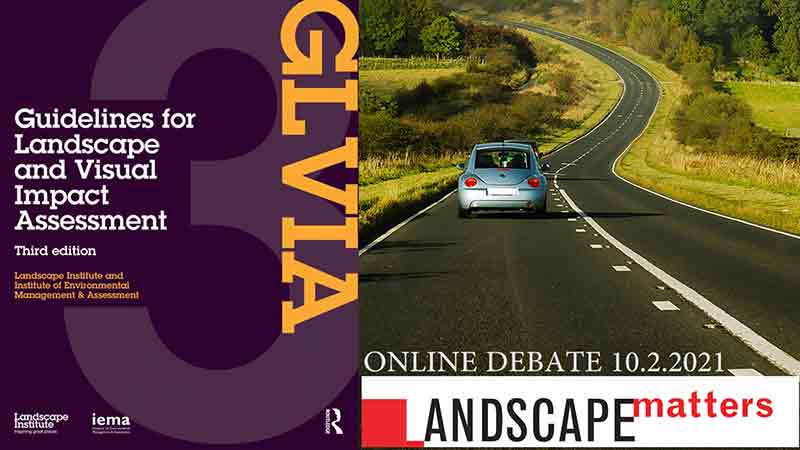GLVIA Guidelines for Landscape and Visual Impact Assessment
The Guidelines for Landscape and Visual Impact Assessment (GLVIA) are published by the UK Landscape Institute LI and used by landscape architects to assess the impact of development projects on the visual landscape and on the natural environment. This expert debate was held by the free journal LANDSCAPEmatters on 10th February 2021. It was introduced by Edward Hutchison and chaired by Tony Edwards. The speakers were the landscape architects Tom Robinson, Sally Marsh, Clare Brockhurst and a planning QC Charles Banner. Tom Robinson, who proposed the debate, believes the Landscape and Visual Assessment Guidelines should be updated (1) to serve current town and country needs better (2) achieve better clarity and transparency. A transcript of the speakers presentations is available for free download and the full debate can be heard on the above video.
Though not participating in the GLVIA Debate I found it stimulating and have been thinking about the underlying issues. In the 1970s and 80s there was a lively discussion about what was called ‘landscape evaluation’ and/or ‘visual quality assessment’ (and ‘scenic quality assessment’ in the US). The word ‘impact’ was not used in these discussions – because this was before the landscape profession had a significant interest in what we now know as Environmental Impact Assessment EIA (I think this interest came from Ian McHarg, and thus from Patrick Geddes). Dominated as it is by scientific concepts and methodologies, EIA has little place for aesthetic judgements and thus has an inbuilt preference for what I see as ‘more scientific’ approaches, including social survey techniques and references to official designations and to literary and cultural associations. My belief is that there is a place for these methods but that professional judgement of landscape quality is also necessary. This is the method that was used when the UK National Parks were selected and demarcated. It is also the method used by David Skinner when commissioned in the 1970s (by the Scottish Development Department) to walk Scotland’s entire coastline and give his professional opinion of which areas should not be used by the oil industry (for terminals, rig construction etc). As in Geoffrey Jellicoe’s work on the yard at Loch Kishorn, the landscape profession was also involved in the mitigation of adverse impacts of the oil industry on Scotland’s landscape.
My suggestions for Landscape and Visual Impact Assessment are:
- revive professional judgement as a technique for the assessment of landscape visual quality
- pair the assessment of visual impact with a full Geddessian and McHargian landscape assessment of the impact of a proposed development on the factors which created the now-existing quality and character the landscape – geology, hydrology, pedology, ecology and a host of other ologies.
In their present form, the GLVIA are constrained by unnecessarily narrow conceptual boundaries. When the earth is dug, let’s remember that the wind blows, the rain falls, the sun shines and eye twinkles.

